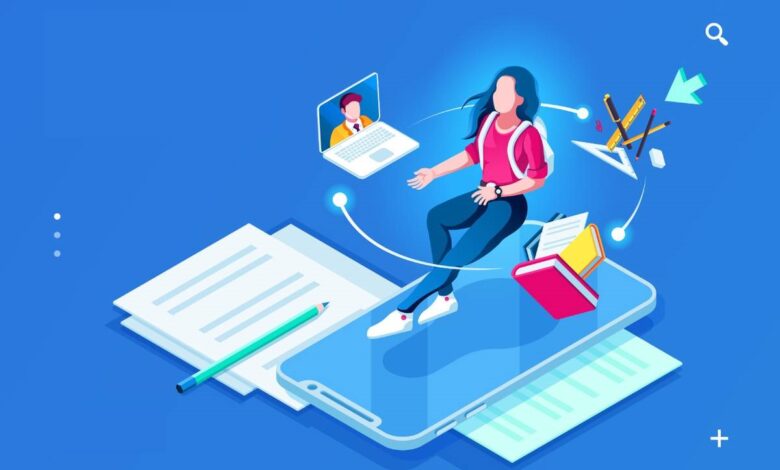
Modern technologies have become a vital part of everyday life. They are used everywhere: in business, science, medicine, education, and in household matters. The most popular modern technologies that are used every day are mobile phones and computers. They are electronic machines that store, process and display data. Such devices are of particular importance in educational facilities since they make the studying process easier and more interesting. Therefore, in the future, teachers and students will take advantage of a wide variety of new technologies that will be helpful in the learning process.
Online Education Is Growing
Mobile phones and computers should be integrated into the learning process because the technologies are penetrating all spheres of human activity. Experts use computers while planning cities, running companies, teaching children, and making prognoses for the future. Moreover, computers and mobile phones connected to the World Wide Web allow access to an immense amount of information. Students, for instance, can use this resource to learn more about other schools, colleges or universities they plan to enter. All the necessary information will be found in a few minutes.
 So, learning how to use new technologies properly allows students to be more effective. Besides, students can download books they need to read and have access to them at any time. With the help of modern technologies, such as web cameras, email, and different social media websites students can communicate with people from all over the world easily and even see a person they are talking to. This enables cross-cultural communication and makes travelling easier, both of which are inevitable in terms of globalization. Therefore, using technologies in the learning environment helps students be more effective in all spheres of their lives.
So, learning how to use new technologies properly allows students to be more effective. Besides, students can download books they need to read and have access to them at any time. With the help of modern technologies, such as web cameras, email, and different social media websites students can communicate with people from all over the world easily and even see a person they are talking to. This enables cross-cultural communication and makes travelling easier, both of which are inevitable in terms of globalization. Therefore, using technologies in the learning environment helps students be more effective in all spheres of their lives.
Without any doubt, modern technologies will enter traditional schools, maths tutoring companies and universities, and they will totally transform the way students learn. Among modern technologies that will be used in digitized classrooms of the future are foldable tablets, electronic paper screens, video lessons, e-library, electronic portfolios, and interactive whiteboards. They can create a special educational environment for making learning more interesting.
Future students will learn easily and quickly because of modern technologies for education which are being developed for the future. The main goal is to create an educational environment which encourages students to read more and learn from anywhere in the world. So these future technologies are being created in mind that they have to be user friendly and also affordable to any student or any school. Teachers will use these future educational technologies to tailor lessons based on students interests.
Students will be more encouraged to learn the new material because the learning process will be very interesting. If, for some reasons, they face challenges with their writing tasks, the 123helpme writing service will always give a helping hand.

In a digitized classroom of the future, students will work with personalized gadgets aimed at improving the learning process. For example, foldable tablets are very helpful and can be used for both learning and teaching. They have a flexible screen that makes presentation of the new material to the class interesting. During these presentations, students can use not only text but also pictures, music or even games. Besides, foldable tablets will help students in their professional development and broaden their learning opportunities.
Teachers will no longer use blackboard and chalk during their lessons. Instead, they will use interactive whiteboards. To do so, teachers will need three components: whiteboard, computer, and data projector to use during lessons. Teachers will have a special pen to manipulate the content on the board: show images, highlight things in different colors, hide or reveal things on the screen or move them around. Teachers will connect the interactive whiteboard to the Internet, and the students will have access to the authentic material.
In the classroom of the future, every student will use his/her personal computer for reading, writing, and searching for information. So the most vivid advantage of digital classrooms is personalized learning that will be more interesting. Students will express themselves without fighting for the teacher’s attention. Besides, these classrooms will enable the use of 3D visualization thus improving the presentation of new material. In digital classrooms, students will also learn some necessary online skills, as well as collaboration and communication. Teachers will use projectors for visual aid.

Thus, they will have some extra time to explain new material because students will not have to write down lectures. All the new information will be saved and posted online. Similarly, electronic paper screen can be used instead of the traditional paper. It is flexible and thin and can display many images. Some electronic papers can have three layers with multiple colors, and students can use either colored versions or white paper. Electronic papers have in-built memory that can save all the images that students have used, so they do not need to download them again. Such innovations are supposed to make the learning process both more efficient and entertaining.
Electronic portfolios will also be popular because they are related to the area of online and computer-based assessment. Students present their assignments in electronic format. This can include video, audio, blogs, websites, and different documents. The portfolios will improve students’ achievements and enhance their desire to learn. Electronic portfolios also can be a good demonstration of each student’s abilities and the possibility for each student to express himself/herself.
There are many benefits of using modern technologies in education. They make lessons more interesting and colorful, and students can express themselves more easily. Teachers and students can find and access any information without putting extra efforts. Students will demonstrate their abilities and creativity using modern technologies for painting pictures, composing music, etc. Books can be available anytime and anywhere. Technologies will make education more interesting and efficient.






